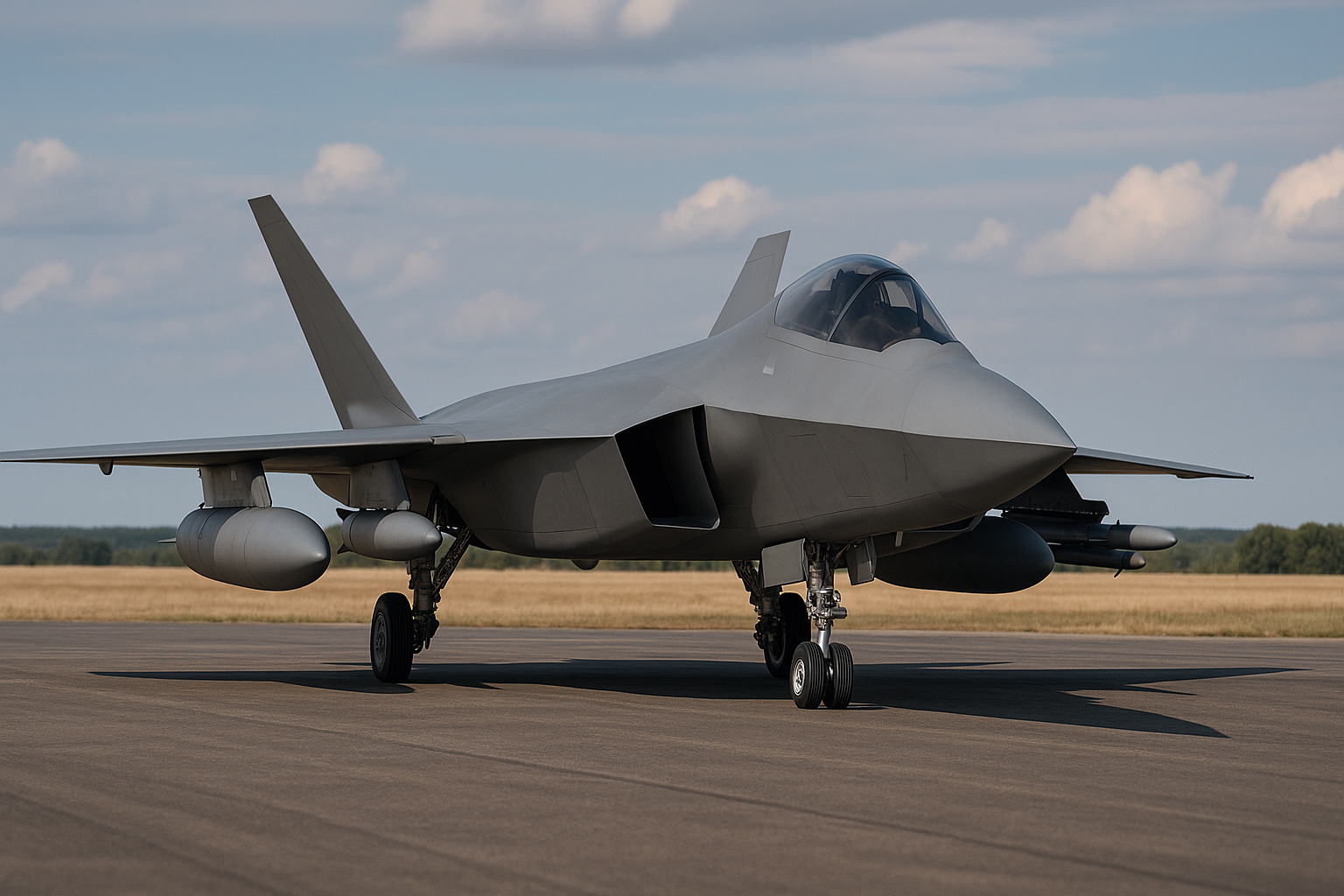MADRID – France, Germany, and Spain signed a trilateral contract on December 15 that launches Phase 1B of the New-Generation Weapon System/Future Combat Air System (NGWS/FCAS). The joint press release names Dassault Aviation, Airbus Defence and Space (Germany and Spain), Indra Sistemas, and Eumet (the Safran Aircraft Engines–MTU Aero Engines joint venture) as prime contractors. Valued at about €8 billion for the full demonstration campaign, it allocates more than €3 billion for the first 36-month work package that starts this month.
The three governments tasked the French procurement agency DGA to act as contracting authority for the group. Officials call the award a decisive moment because it clears the way for hardware that until now existed only in digital mock-ups. The headline target is a first crewed demonstrator flight of the New Generation Fighter (NGF) before the end of 2028. Industry leaders say they can meet that date if the programme retains steady cash flow and political backing.
NGWS/FCAS is structured as a “system of systems.” At its centre sits the NGF, which will operate in concert with expendable or recoverable unmanned Remote Carriers and connect to legacy fighters, satellites, naval assets, and air-defence nodes through a Combat Cloud. This vision for the NGF is similar to the French-German MGCS future tank program, which also emphasizes joint operations and interoperability. The cloud will fuse sensor data, allocate targets, and push tactics and mission-planning updates in real time while respecting each nation’s security policy.
Programme chiefs divided Phase 1B into eight technology pillars so that work share mirrors national investments:
- NGF airframe: Dassault leads, Airbus supports
- Propulsion: Safran heads the core, MTU drives German work, ITP Aero handles Spanish tasks
- Remote Carriers: Airbus Germany leads, MBDA shapes weapon interfaces, SATNUS manages Spanish sub-systems
- Combat Cloud: Airbus Germany shapes architecture, Indra guides Spanish effort, Thales supplies cyber-resilient links
- Sensors: Indra coordinates, with Thales and FCMS contributing
- Low-observability: Airbus Spain steers signature reduction with Dassault input
- Simulation & common labs: the three primes share governance
- Overall coherence: joint study teams ensure design choices stay aligned across pillars
Phase 1B covers wind-tunnel trials, stealth coatings, propulsion rig tests, and remote-carrier sub-scale flights. Every sub-contract triggers strict milestones tied to payments, a lesson learned from earlier delays. France recently struck a contract for the next phase of FCAS, setting the groundwork for this critical work. DGA placed 42% of the initial €3 billion with French firms, BAAINBw placed 33% with German industry, and Spain’s DGAM placed 25 %. That split follows the funding profile set out in the 2021 trilateral framework accord.
Officials highlight three near-term demonstrations:
- A full-scale NGF iron-bird to evaluate flight-control laws and avionics
- An adaptive-cycle engine core run at Safran’s Villaroche facility
- A loyal-wingman flight test that uses a modified Airbus Do 328JET as the mothership
DGA programme manager Brig Gen Philippe Koffi noted that the iron-bird allows hardware-in-the-loop checks years before first flight, cutting risk on hydraulics and power-by-wire functions. Airbus Germany’s FCAS vice-president Michael Schoellhorn added that digital twins can test 200 mission scenarios a day, trimming costs on range time and dummy ordnance.
Industrial partners say the programme anchors more than 10 000 high-skilled jobs across the three nations. Dassault chief engineer Bruno Chevrier estimates that 1.2 million engineering hours will be logged during the 36-month block alone. Indra forecasts that 80 % of its FCAS subcontractors are small or medium-sized enterprises focused on software and photonics.
Work on sustainment concepts starts early. Airbus Spain’s head of support solutions Isabel Delgado confirmed that digital thread data captured during build and test will populate maintenance tablets for future squadrons, cutting fault-finding time by 30 %. Environmental standards also frame the design: the engine core must accept up to 50 % sustainable aviation fuel during flight testing, rising to 100 % by entry into service.
The three defence ministries intend to celebrate the award in Madrid in early 2023, once parliaments release remaining appropriations. For planners, keeping momentum matters as the aircraft must replace French Rafales, German and Spanish Eurofighters in the 2040s. Without a sixth-generation solution made in Europe, capitals fear long-term reliance on non-EU suppliers.
First metal cut on components begins in mid-2023 at Dassault’s Argenteuil plant, while MTU prepares turbine blades in Munich. By late 2024 engineers will join the fuselage barrels at a new low-observability hall near Getafe. These steps feed a tight schedule that still reserves only 18 months from rollout to maiden flight. An early freeze on interfaces tries to avoid late redesign churn.
Digital design choices also aim to prevent configuration creep. The common Product Lifecycle Management (PLM) backbone already runs at 1.2 petabytes and grows daily. Teams log digital changes within 24 hours across the Franco-German-Spanish “SimLab” network, forcing discipline in architecture decisions. As a result, officials say, the open-system avionics bus can insert third-party apps without rewriting core flight code.
Programme governance mixes politics and pragmatism. A three-nation Steering Committee meets every two months, rotating host capitals so each partner shares travel burden. Its twin-track format puts operational users and acquisition chiefs in the room together, a switch from earlier projects where forces saw prototypes only after long design loops.
Remote-carrier studies place heavy focus on airspace integration. Eurocontrol accepted a concept of operations that keeps manned-unmanned traffic inside existing conditional-route structures until 35 000 ft, easing regulatory traction. At the same time, MBDA tests modular rail-launch pods that fit both the NGF and upgraded Rafales, ensuring early weapons prove-out with current fleets.
Sensor work revolves around distributed aperture arrays built on gallium-nitride tiles. Indra leads integration trials at Morón Air Base, feeding data into a Dassault-supplied fusion kernel. Developers claim that the low-latency chain can handle 15 gigabits per second without network drop-outs, even when the host platform banks at 9 g.
A side benefit of the joint project is tighter European control over encryption keys. Thales cyber experts package cryptographic chips under the EU’s Common Criteria EAL4+ standard, letting each capital manage compartmentalisation without resorting to US or Israeli key-loaders. That move meets a long-standing sovereignty demand from the French Senate’s defence committee.
Looking beyond Phase 1B, partner nations eye a follow-on Phase 2 contract worth roughly €5 billion to run from 2026 to 2030. It should fund full-scale prototypes of the NGF, Remote Carriers, and the Combat Cloud backbone. Defence ministers say they will request initial payments in their 2025 national budgets so Phase 2 can begin without a hiatus.
WHAT’S NEW – MARCH 2025 UPDATE
French, German, and Spanish officials spent most of 2023 ironing out the workflow friction that had delayed contract signature by nearly two years. By autumn the common Simulation Laboratory reached full operating status, and the first cross-border coding sprints delivered flight-control software blocks on schedule. Airbus test pilot Frank Bettels praised the “zero-latency hand-off” between signal-processing teams in Manching and Torrejon, a change he says cuts risk before hardware tests even start.
December 2023 saw the maiden flight of a sub-scale Remote Carrier demonstrator from DGA’s Biscarrosse range. The jet-powered vehicle performed way-pointing exercises with a French A330 MRTT acting as surrogate command post. Data from the sortie confirms that the autonomous collision-avoidance logic remains stable in heavy rain – welcome news for navies that intend to operate the system over the Bay of Biscay.
Throughout 2024 engineers used digital twins to refine stealth lines on the four NGF concepts under review. Wind-tunnel campaigns at ONERA Modane recorded an average 12 % drag reduction against the 2022 baseline, nudging endurance targets closer to the two-hour combat radius demanded by Germany. Remote-carrier bay doors also shrank in outline, trimming signature while still accepting mixed weapon pairs.
Late 2024 brought a sprint to narrow those four fighter concepts to two. Breaking Defense reported that a final down-select would come by March 2025, and insiders confirm the decision landed on time. Officials picked a tailless delta for carrier use and a cranked-kite variant optimised for high-altitude loiter. The choice balances French naval needs against German Luftwaffe preference for range at medium weight.
On March 14 2025 the three armaments directors met in Bonn and locked the reference design. The agreement covers planform, sensor apertures, and inlet geometry, securing the frozen external shape that tooling teams need. A joint communiqué stressed that no nation accepted a concession on sovereign mission requirements, signalling political unity after years of debate.
Meanwhile Safran lit off the prototype engine core in February 2025 at Villaroche. Engineers achieved 37 000 lb thrust in dry power on the first run, matching phase-gate targets. MTU technicians noted that the composite blisk showed no delamination after the 20-minute cycle, evidence that ceramic-matrix manufacturing choices pay off. The core now moves to altitude testing at Isar Aerospace’s high-altitude chamber.
Indra and Airbus Spain activated the first Combat Cloud testbed over Spain’s Canary archipelago in January 2025. An A400M acting as flying server relayed target files to a Spanish C.15M Hornet and an Airbus H-215M helicopter. Latency stayed under 50 milliseconds across a 500-kilometre link, validating the meshed-satcom concept that underpins the NGWS network layer.
Germany’s Bundestag approved an extra €1.2 billion in March 2025 to hedge inflation spikes and energy-cost hikes. That vote secures engine and sensor spending lines through mid-2026, avoiding stop-work risk if Phase 2 talks slip. Berlin’s move follows a French allocation in the 2025 Loi de Programmation Militaire and a Spanish credit in the 2025 Presupuestos Generales del Estado.
Programme leadership still battles public clashes. Dassault CEO Éric Trappier told French lawmakers in April 2025 that cooperation with Airbus remains “very, very difficult,” citing interface rights on flight-control laws. The ongoing tensions mirror earlier disputes over 80% of FCAS workshare, which has created strain within the partnership. Airbus Defence CEO Michael Schöllhorn answered that integration work continues “without show-stoppers” and warned against public drama that could harm export credibility.
Despite friction, senior officers see solid momentum. At the Royal Aeronautical Society summit in London on May 21 2025, Maj Gen Jean-Luc Moritz said Phase 2 launch documents are “cut and paste ready.” Brig Gen Philippe Koffi added that first fuselage barrels for the flying demonstrator will enter cure ovens in early 2026, with rollout pencilled for late 2028. This steady progress mirrors how Europe could co-build U.S. Collaborative Combat Aircraft after the Paris Air Show reveal.
Current schedules still predict first NGF flight in 2029, Remote Carrier demonstration in 2028, and limited Combat Cloud operational capability in 2030. Officials accept that any budget shock or major design change could slip those dates, yet they say the digital-first workflow gives engineers margin to absorb setbacks faster than in legacy programmes.
The partners now focus on finalising the Phase 2 Statement of Work before the 2025 summer recess. Negotiators aim to send contract drafts to parliaments in October so funding lines clear by June 2026. If the timeline holds, full-system demonstrator flights will mark Europe’s largest defence-technology showcase since the 1980s – exactly the political signal planners hoped to send when they shook hands on the Phase 1B award back in December 2022.
REFERENCE SOURCES
- https://www.defenceiq.com/air-forces-military-aircraft/articles/the-fcas-programme-explained-a-beginners-guide
- https://www.airbus.com/sites/g/files/jlcbta136/files/2022-12/en-joint-press-release-fcas-demophase-1b-contract_0.pdf
- https://www.reuters.com/business/aerospace-defense/france-strikes-contract-next-phase-fcas-jet-with-dassault-aviation-airbus-indra-2022-12-15/
- https://www.indracompany.com/sites/default/files/221215_pr_indra_fcas_phase_1b.pdf
- https://www.mtu.de/de/newsroom/presse/aktuelle-presseinformationen/press-release-detail/europes-future-combat-air-system-on-the-way-to-the-first-flight/
- https://www.ifri.org/sites/default/files/migrated_files/documents/atoms/files/ifri_mohring_fcas_mgcs_weapon_systems_2023.pdf
- https://www.flightglobal.com/defence/europes-fcas-programme-making-strong-progress-french-officials-say/163103.article
- https://breakingdefense.com/2023/11/fcas-weighing-4-fighter-designs-could-make-final-choice-by-march-2025/
- https://www.defensenews.com/global/europe/2025/04/11/dassault-ceo-strikes-dark-tone-on-europes-sixth-gen-fighter-progress/
- https://www.shephardmedia.com/news/air-warfare/fcas-programme-gearing-up-for-phase-2-by-mid-2026-say-french-officials/



